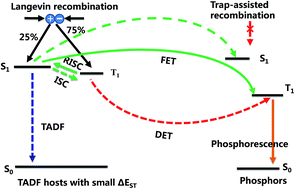Towards ideal electrophosphorescent devices with low dopant concentrations: the key role of triplet up-conversion†
Abstract
Phosphorescent organic-light emitting diodes (PHOLEDs) have achieved ultimate high efficiencies and long lifetimes. One of the remaining challenges in PHOLEDs is to reduce the cost, which can be accomplished by reducing the dopant concentration. Here, to promote energy transfer at low dopant concentrations, hosts with thermally activated delayed fluorescence (TADF) are utilized. The triplet excitons of the host with TADF can be thermally up-converted to their singlet states and then transferred to the guest through the long-range Förster energy transfer rather than the short-range Dexter one. Devices using 2-phenyl-4,6-bis(12-phenylindole[2,3-a]carbazole-11-yl)-1,3,5-triazine (PBICT) as the host for tris(2-phenylpyridine)iridium (Ir(ppy)3) achieve a maximum external quantum efficiency of 23.9% and a power efficiency of 77.0 lm W−1 at a low dopant concentration of 3 wt%. Moreover, unlike the traditional hosts, the lifetimes of devices using hosts with TADF are less sensitive to dopant concentration with the longest lifetime obtained at 3 wt% Ir(ppy)3. The findings may provide a novel strategy to simultaneously achieve high efficiency, low driving voltage and long lifetimes in PHOLEDs at a low phosphor concentration of ≤3 wt%.


 Please wait while we load your content...
Please wait while we load your content...